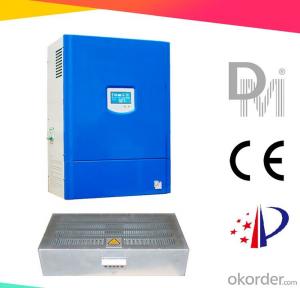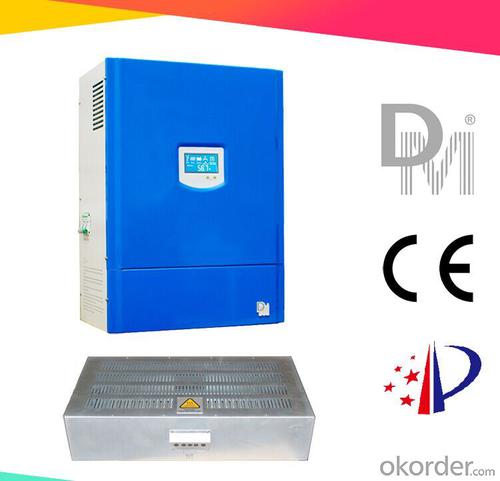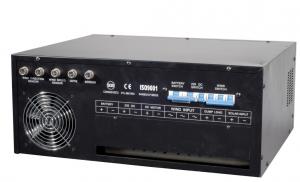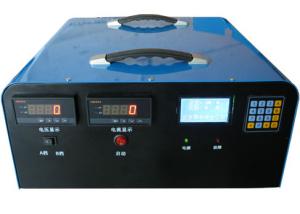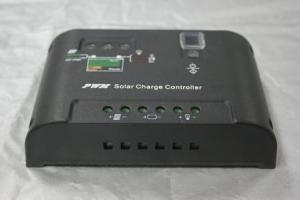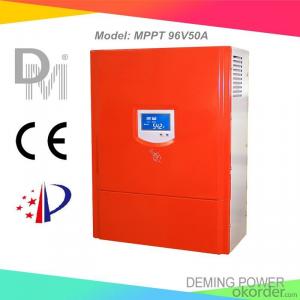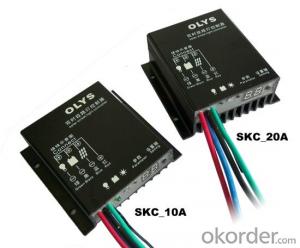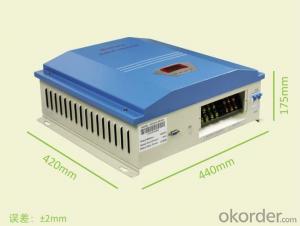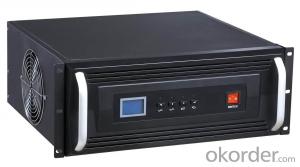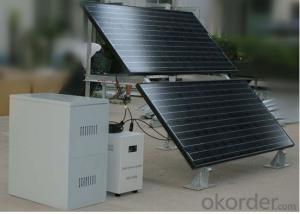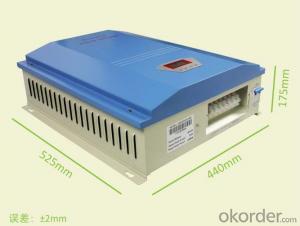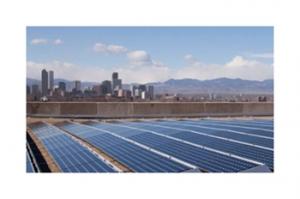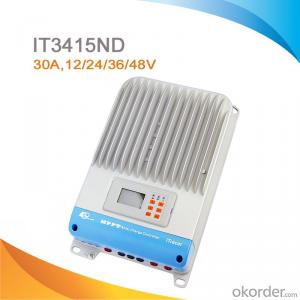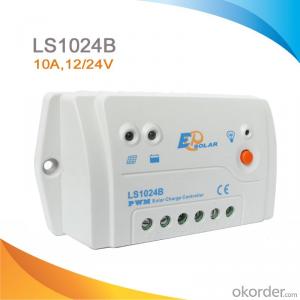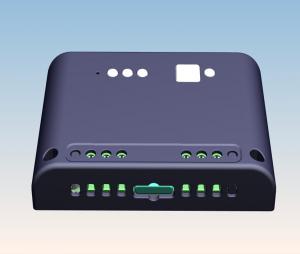Off-Grid PWM Wind Solar Hybrid Controller2KW
- Loading Port:
- Qingdao
- Payment Terms:
- TT or LC
- Min Order Qty:
- 1 unit
- Supply Capability:
- 1000 unit/month
OKorder Service Pledge
OKorder Financial Service
You Might Also Like
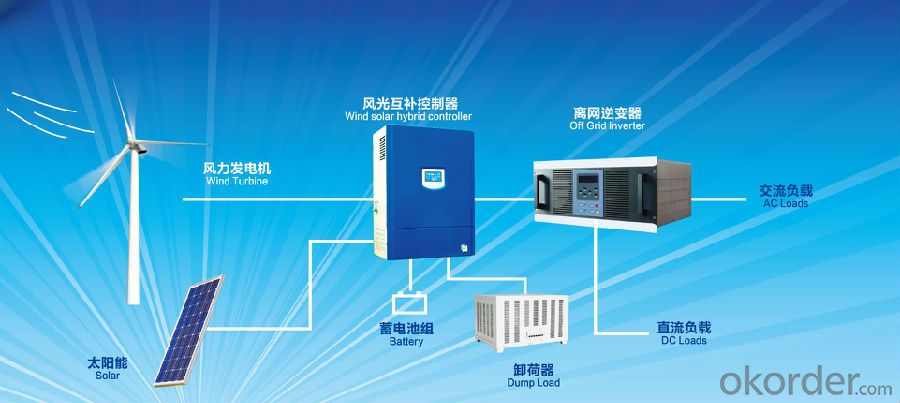
FKJ-B model Product Characteristics
◆The product is manufactured according the JB/T6939.1-2004 industrial standard and GB/T 19115.1-2003 national standard also with users’ technical requirements.
◆The big screen LCD display. Clearly present the working status of the wind turbine, solar panel, battery and controller.(Wind turbine voltage, current, power display ;solar voltage, current, power display, battery charging current, voltage, charging power, power display.)
◆Two sets of control systems:PWM constant voltage system and three-phase dump load system.
◆PWM constant voltage control is 120% of the rated power of the wind turbine. In case exceeding of PWM’s capacity, the three-phase dump load will automatically start immediately to ensure safe running of the overall wind turbine system.
◆When the battery disconnect or damage, the three-phase dump load will start automatically to avoid the wind turbine idling and runaway accident.
◆When the strong or super-strong wind conditions PWM control to ensure battery charged by the wind turbine with constant voltage and current.
◆The protection function of battery: polarity reverse protection, disconnection and damage protection.
◆Over-charging protection of the battery: When the battery is full (the battery voltage getting 125% of the rated voltage), the controller will carry out three-phase dump load automatically to stop charging the battery.
◆Auto recharging of battery: When the battery voltage reduces to 108% of the rated voltage,it stops three-phase dump load to recharge battery automatically.
◆For the different wind turbine type, the controller can be equipped with mechanical yawing, furled empennage, mechanical or hydraulic, pneumatic, electric magnetic and other brake functions.
◆The inside of the controller is equipped with surge arrester. Contain the over voltage into the wind turbine under the bearable voltage of the equipment or system. On the other way, to conduct the strong lightening current into the earth directly to avoid any damage of equipment.
◆The controller is equipped with manual three-phase dump load switch. To using this switch, the wind turbine will carry out three-phase dump load forcibly.
◆ Optional communication Mode:RS232、RS485、GPRS、USB、RJ45 ect, Can monitor multiple devices running.
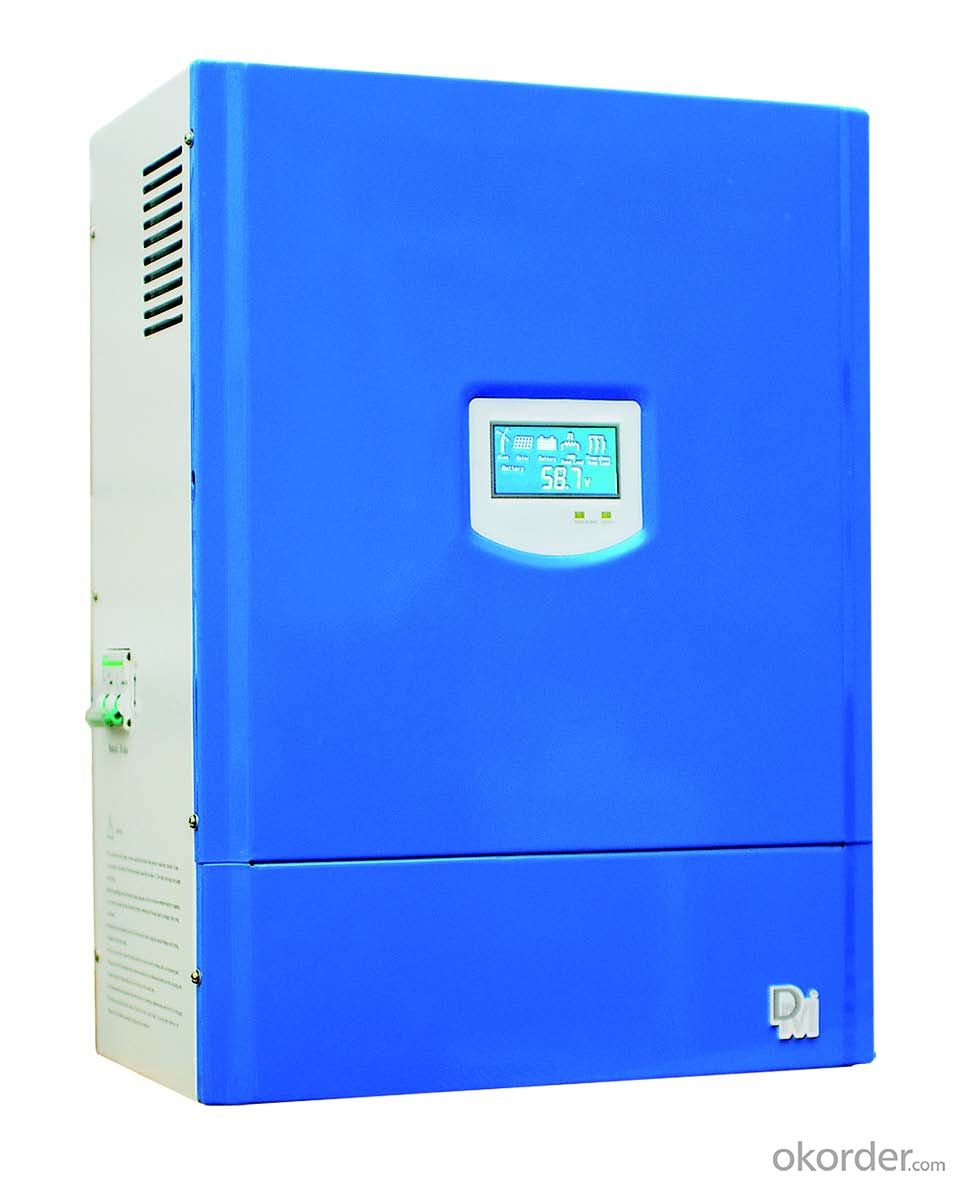
Technical Parameters of the FKJ-B (PWM) Off - Grid Wind Solar Controller 2KW
Type | 2KW-24Vdc | 2KW-48Vdc | 2KW-96Vdc |
Wind turbine rated power | 2KW | 2KW | |
Wind turbine max. power | 4KW | 4KW | 4KW |
Solar panel power | 600Wp | 600Wp | 600Wp |
Battery | 24Vdc | 48Vdc | 96Vdc |
Function | Rectifier,charge, control | ||
Display mode | LCD | ||
Display content |
Wind turbine voltage, wind turbine current, wind turbine power, solar panel voltage, solar panel current, solar panel power, battery voltage, charge current | ||
PWM constant pressure voltage | >29Vdc | >58Vdc | >116Vdc |
3-phase load voltage of the wind turbine | 30±1Vdc | 60±1Vdc | 120±2Vdc |
Recovery charging voltage of the wind turbine | 27±1Vdc | 54±1Vdc | 108±2Vdc |
Solar controller stop charging voltage | 29±1Vdc | 58±1Vdc | 116±2Vdc |
Solar restore charge voltage | <29vdc< span=""> | <58vdc< span=""> | <116vdc< span=""> |
Low-voltage of the battery | 20±1Vdc | 40±1Vdc | 80±2Vdc |
Self-provided connecting wire of the battery | >20mm² | >10mm² | >24mm² |
PWM fuse | 100A | 50A | 20A |
Solar fuse | 40A | 20A | 10A |
Charging fuse | 125A | 63A | 32A |
Work environment temperature | -30-60°C | ||
Relative humidity | <90% No condensation | ||
Noise (1m) | <40dB | ||
Degree of protection | IP20 | ||
Cooling method | Forced air cooling | ||
*Communication interface (optional) | RS485/USB/GPRS/Ethernet | ||
*Temperature compensation (optional) | -4mv/°C/2V,-35°C~+80°C, Accuracy:±1°C | ||
Size of the controller (mm) | 480*360*130 | 480*360*130 | |
Weight of the controller | 23 Kg | 16 Kg | 16 Kg |
Size of the dump load (mm) | 395*300*125 | 395*300*125 | 395*300*125 |
Weight of the dump load | 6.5 Kg | 6.5 Kg | 6.5Kg |
*Above parameter only for reference
1. Could be custom made to user specifications.
2. Could have solar power control subject to user demand.
3. Size of the controller by blue meaning wall hanging case.
- Q: Can a solar controller be used with a solar-powered beekeeping system?
- Yes, a solar controller can be used with a solar-powered beekeeping system. A solar controller helps regulate and optimize the charging and discharging of the batteries in a solar-powered system. It ensures that the batteries are charged efficiently and protects them from overcharging or discharging. Using a solar controller in a solar-powered beekeeping system can help improve the overall performance and reliability of the system.
- Q: Can a solar controller be used with a solar pool heating system?
- Yes, a solar controller can be used with a solar pool heating system. A solar controller helps to regulate and monitor the flow of water and temperature in a solar pool heating system, ensuring optimal performance and efficiency. It allows users to set desired temperatures and control the operation of the system, making it an essential component for managing and maximizing the benefits of solar pool heating.
- Q: Can a solar controller be used with a battery backup system?
- Yes, a solar controller can be used with a battery backup system. A solar controller is responsible for regulating the charge from solar panels to the battery, and it can also manage the discharge from the battery to power various devices. Therefore, it plays a crucial role in ensuring the efficient and safe operation of a battery backup system.
- Q: Can a solar controller be used with a solar-powered electric vehicle charging infrastructure?
- A solar controller can indeed be utilized alongside a solar-powered electric vehicle charging infrastructure. Referred to as a charge controller as well, this device is responsible for regulating the flow of electric current from solar panels to batteries or other devices. In the specific scenario of a solar-powered electric vehicle charging infrastructure, the solar controller would oversee the charging process by ensuring that the electricity produced by the solar panels is effectively stored and transmitted to the electric vehicle's battery. This aids in optimizing the charging efficiency and extending the battery's lifespan. Furthermore, a solar controller is also capable of offering crucial monitoring and safety features, including overcharge protection and temperature compensation, which are vital for the secure and efficient operation of a solar-powered electric vehicle charging infrastructure. All in all, incorporating a solar controller into a solar-powered electric vehicle charging infrastructure can enhance its performance, reliability, and sustainability.
- Q: How does a solar controller prevent damage to the solar panels from lightning strikes?
- A solar controller helps prevent damage to solar panels from lightning strikes by implementing several protective measures. Firstly, it usually includes a built-in surge protector that is capable of diverting excess voltage from lightning strikes away from the panels. This surge protector acts as a barrier, preventing the high voltage from reaching the panels directly. Additionally, solar controllers often come with grounding mechanisms. These grounding systems provide a safe path for lightning-induced currents to flow, redirecting them safely into the ground. By providing an alternative route for the electrical energy, the solar controller ensures that the panels are not directly exposed to the potentially damaging effects of lightning strikes. Furthermore, some advanced solar controllers also employ monitoring and detection systems. These systems use sensors to detect changes in atmospheric conditions, such as the buildup of static electricity or the presence of lightning activity. If a potential lightning strike is detected, the solar controller can automatically disconnect the panels from the power source and ground them, effectively isolating them from the electrical surge. Overall, a solar controller acts as a crucial protective device for solar panels during lightning strikes. Through the utilization of surge protectors, grounding systems, and detection mechanisms, it minimizes the risk of damage to the panels by diverting excess voltage, providing a safe path for currents, and disconnecting the panels when necessary.
- Q: What are the safety features of a solar controller?
- Some common safety features of a solar controller include overcharge protection, short circuit protection, reverse polarity protection, and over-discharge protection. These features help prevent damage to the solar controller and the connected battery system, ensuring safe and efficient operation.
- Q: What are the advantages of using a solar controller in a solar system?
- The advantages of using a solar controller in a solar system are that it helps to regulate and optimize the charging and discharging of batteries, protects the batteries from overcharging and over discharging, increases the efficiency of the solar system by preventing power loss, and extends the lifespan of the batteries. Additionally, solar controllers can provide monitoring and diagnostic capabilities, allowing for better control and management of the solar system.
- Q: How does a solar controller handle the monitoring of system performance?
- A solar controller monitors the performance of a solar system by continuously measuring and analyzing key parameters such as solar panel voltage, current, and temperature. It also monitors the battery voltage and temperature in case of a battery-based solar system. By tracking these parameters, the solar controller can determine the overall system performance, identify any issues or faults, and take necessary actions such as adjusting the charging rate to optimize the system's efficiency and prevent overcharging or damage to the batteries. Additionally, some advanced solar controllers may offer remote monitoring capabilities, allowing users to access real-time performance data and receive alerts or notifications about system performance through mobile apps or online platforms.
- Q: Can a solar controller be used with solar-powered charging stations?
- Yes, a solar controller can be used with solar-powered charging stations. A solar controller helps regulate the flow of electricity from the solar panels to the charging stations, ensuring efficient charging and preventing overcharging or damage to the battery. It also helps optimize the energy harvested from the solar panels, increasing the overall efficiency of the charging stations.
- Q: How do I protect a solar controller from electromagnetic interference?
- To protect a solar controller from electromagnetic interference, you can take a few measures. Firstly, make sure the controller is installed in a location away from other electronic devices that emit electromagnetic radiation. This will minimize the chances of interference. Additionally, using shielded cables and grounding the system properly can help reduce electromagnetic interference. Lastly, you may consider using ferrite beads or filters to suppress any potential interference.
Send your message to us
Off-Grid PWM Wind Solar Hybrid Controller2KW
- Loading Port:
- Qingdao
- Payment Terms:
- TT or LC
- Min Order Qty:
- 1 unit
- Supply Capability:
- 1000 unit/month
OKorder Service Pledge
OKorder Financial Service
Similar products
Hot products
Hot Searches
Related keywords
